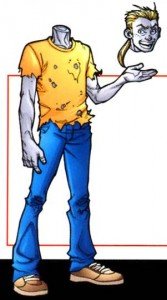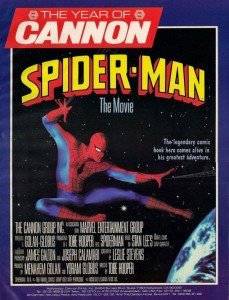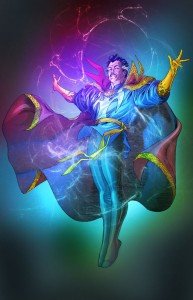10 Comic Book Movies That Were Almost Made
It’s no secret that I’m a huge superhero movie nerd! I love those films. Sure, I can be critical of some of them at times but overall, as a genre, I’m a fan. I own a ton of Marvel encyclopedias and multiple runs of the “Marvel Universe” comics. I’ve also read a multitude of online stories about film rumors, productions, and trivia.
Recently, actor-director-animator Jon Schnepp finished his passion project, The Death of “Superman Lives”: What Happened. This is a documentary about the development of the 1998 Superman Lives feature film with Nicolas Cage in the starring role. Many people have heard about this film or have seen the photos circulating online of Cage in his Superman costume, or heard Kevin Smith discuss his involvement during his Q&A tours. What many don’t know is how far along this film actually was before being dropped. Schnepp’s film goes into detail with almost all the principals involved: writers, directors, producers. I paid some of my hard-earned money (via FanBacked.com) to see this project come to fruition. I attended the film’s Houston premiere and absolutely loved it, and the film is now available for order online at tdoslwh.com (plug!). This all got me thinking… what other great comic book projects almost got made, or that we’re thankful were not! I started combing through all the vast resources at my command (…the interweb via my trusty laptop) and soon found a plethora of dead film projects! Some were dead even before they began so I won’t even cover those, others were almost immediately rewritten into projects we ended up seeing so I won’t talk about those either. No, the ones I’m going to tell you about are the hidden, deep, dark secrets that Marvel and DC don’t talk about much (some for good reason!), as well as some that were eventually developed into projects with which we’re more familiar.
So, without further ado, here we go:
Bo Derek’s Dazzler
This comes direct from “Big Jim” Shooter, former editor-in-chief of Marvel Comics for nine years (1978-1987). He was the man at the helm during some of the biggest years of Marvel Comics. Some of you might already about the comic character, Dazzler; a mutant with the ability to convert sound vibrations into light and energy blasts, who enjoys a successful career as a disco singer with her own personal light show. What most people don’t know, however, is that the character was actually developed as a tie-in for releasing popular music.
According to Shooter, in early 1979, a big wig at Marvel proposed a character who was not only a superhero but who also enjoyed a prosperous singing career. They wanted to establish a joint business venture with a record company. Marvel would put out the comics and the record label would producing the music, using various studio musicians, and then market them as the comic character (something similar to Miley Cyrus’ Hannah Montana television show and concurrent singing career in the persona of the character – man, I bet many miss those halcyon days – geesh, Miley, put some clothes on!).
Jim Shooter assigned the project to writer Tom DeFalco and artist extraordinaire John Romita, Jr. Together, with Shooter, they created Alison Blaire, the beautiful Dazzler. They explained that she would be able to openly use her mutant abilities as a performer under the pretense that the light show was part of an elaborate secretive stage setup. Dazzler had her comic debut in February 1980’s Uncanny X-Men #130.
Marvel then met with Neil Bogart of Casablanca Records and Filmworks, who not only wanting the joint venture but to launch the project with a half-hour animated feature. Bogart had the idea of expanding the animated feature so as to include the voice talents of his many signed recording artists, such as KISS, the Village People, and Donna Summer. If they were going to move forward on this, they needed a story treatment in four days. That was not enough time to bring in a new writer and get him acquainted with the character, so Jim Shooter wrote the treatment himself (a copy of which can be found online if you look hard enough…). When he turned it in, Bogart loved it and immediately decided that this was no longer a half-hour special, but a full-length feature film.
Neil Bogart was sick at the time with him passing away soon after. Casablanca and Filmworks were being sold and the Dazzler project was put on the shelf. However, Marvel owned the project outright, Casablanca had no financial interest in it as of yet. Therefore, in spring 1980, Alice Donenfeld, Marvel’s VP of Business Affairs, attended the Cannes Film Festival, and took the treatment along. She attempted to shop the treatment around to any interested parties and was able to get a meeting with Bo Derek.
Bo Derek was hot off her biggest film role as the perfect “10.” She read Shooter’s treatment and was sincerely interested in playing the title role of Dazzler. If you happen to come across an early 1980 copy of People Magazine featuring Bo Derek and her husband, John, on the cover, you’ll notice John carrying a stack of Marvel Comics. That photo was taken at Cannes after her meeting with Donenfeld (Donenfeld was cropped out of the photo).
With Bo Derek attached this meant guaranteed studio funding as Bo was the hottest star in Hollywood at the time. Marvel then brought in a professional screenwriter, Leslie Stevens, who basically discarded Shooter’s treatment and developed a story for a more campy film. Shooter recalls the screenplay was absolutely moronic, changing Dazzler’s abilities from light powers to the power to compel others to tell the truth. Really? Okay, so they were still moving forward with the project, with studios bidding higher and higher on which was going to get it. During this hype, Bo Derek demanded that for her to be in the film, her husband, John, had to be the director. Reluctant to back a film directed by Derek, known for his temperamental ways, shooting delays, and going over budget, every bidding studio backed out. Bo Derek subsequently severed her relationship with Marvel.
Soon after, Marvel, still using the Leslie Stevens script with Daryl Hannah now attached to star, tried to shop it around to studios once more, but none were interested. The project was dead.
I don’t know how I feel about this project. Disco was dying a slow death by this point but Jim Shooter has said that Dazzler’s music tastes evolved and the film most likely would’ve been more pop-oriented. I love Bo Derek. I heard she was going to be at a television studio in Los Angeles once and I was able to get her to sign a couple of her Playboy Magazines for me. She was a real sweetheart. During the height of her fame, this film might have been a hit, despite the changes to the Dazzler character. We’ll never know.
Silver Surfer the Musical
Now this is one that you will find hard to believe, but trust me, it’s true. If you’re unfamiliar with the character, he was created by Jack “King” Kirby, and made his first appearance in the comic, Fantastic Four #48 (March 1966). The Silver Surfer is a metallic-skinned alien who travels throughout the universe on his metallic “surfboard.” He was once Norrin Radd of the planet Zenn-La. When the ultimate binge-eater, Galactus shows up to devour his planet, Norrin saves his world by offering to serve as his herald and finding him sufficient worlds to eat. The all-powerful Galactus imbues Norrin with just a small amount of his awesome Power Cosmic, transforming Norrin into the immensely powerful Silver Surfer allowing him to travel at light speed on his surfboard. He then serves his master by traveling the universe seeking out planets for Galactus to consume. When he comes upon Earth, he is befriended by the Fantastic Four (have you seen that Jessica Alba film, Fantastic Four: Rise of the Silver Surfer?) and decides to help them repel Galactus, saving Earth. In punishment, Galactus basically fires him and exiles him to Earth (which he eventually breaks escapes and becomes free again to roam the universe as he wishes). Okay, so we’re all clear on that. I mean, what about that story doesn’t scream, “Musical!”
Sean Howe, in his book, Marvel Comics: The Untold Story, states this was indeed a movie that was being developed. It was the early 1980s, Lee Kramer, the executive producer of Xanadu, had a vision for a musically-enhanced film about the Silver Surfer. Kramer wanted an epic film with a contemporary rock and roll soundtrack. He wanted the herald of Galactus to enter being, well, heralded by an incredible chant and the music of a thousand electric guitars!
This film would’ve starred Olivia Newton-John, not as the surfer, of course, and possibly scored by none other than Paul McCartney! McCartney was a comic fan and, according to Steven Shrimpton, his manager at the time, Sir Paul was very interested in the concept of turning this into a rock opera.
However, the film idea faded away after the poor box office reception to Xanadu. Kramer went on to focus on other projects. Would this have been successful? I think it would be hit or miss. Olivia Newton-John and Sir Paul can both put out the music, but would that be enough to sustain the film? If done right, this could’ve been epic! If done wrong, equally as bad. I guess we’ll never know. Or, will we? Naw, we won’t!
Brigitte Nielsen’s She-Hulk
It was the late 1980s, early 90s, with the success of The Incredible Hulk television series, Marvel wanted to try to bring their other Hulk property, She-Hulk, prime time success as well. The rumors are that professional volleyballer and all-around hottie Gabrielle Reece would’ve starred as She-Hulk while another actress, Mitzi Kapture, would appear as her alter-ego, Jennifer Walters. Soon, ABC announced the proposed “She-Hulk” show a dead project, so Marvel instead tried to make it into a full-length feature.
Now even this is conjecture. Most of this is shadowy and no one seems to know for sure what the deal was with this project. All we know for sure is that around 1989, New World Pictures, the film company founded by Roger Corman, hired Brigitte Nielsen to pose for some promotional photos as She-Hulk. All other details on the project are murky. Some claim Nielsen was set to star in the film, others that she was being considered. There are many stories out there about prolific television staple Larry Cohen being attached to write and direct, however, I can find no actual statements by him or a studio to confirm this.
I believe that this was a film project in development, otherwise why would Marvel allow a film studio to commission promotional photos with a big-name star (remember, in 1989, Nielsen was only two years removed from a string of her biggest films – Red Sonja, Rocky IV, Cobra, Beverly Hills Cop II). She was a good choice for the role, physically-speaking or course. Her acting? Well, that’s a story for another time.
However, a She-Hulk movie before a Hulk movie? That is a question that is hard to answer. Although the television series was canceled in 1982, the studios were cranking out made-for-TV movies in 1988, 1989, and 1990, with another being planned until Bill Bixby’s health began to decline. Was it too soon for Hulk film, with Bixby having passed in 1993? At the time, were they leaving Hulk on TV, and moving forward cinematically with his less-popular cousin? That’s hard to believe. All we know for sure is that nothing ever became of it and all we have left are the green-tinted photos of Brigitte Nielsen that are floating around in cyberspace.
Mort the Dead Teenager
Marvel Comics literally has thousands of characters from which to draw from in developing film projects. The fact that someone thought this one was ripe for his cinematic debut is incredible!
In case you’re not sure just who is Mort the Dead Teenager? He is an obscure comic character, created by Larry Hama and Gary Hallgren who appeared briefly in his own mini-series in 1993. The story is that Mort Graves is a teenager who is bullied a lot. One day, he dies in a car accident and meets the Grim Reaper’s son, Teen Death. Teen Death returns Mort to Earth to haunt and generally freak out all those who mistreated and bullied him, and attempts to impress the girl of his dreams. So Mort is dead therefore he can’t be killed again and he has the ability to remove his head whenever he so chooses. Funny right? A little morbid, but okay, I’ve seen films with… similar ghostly premises.
Well, if you can believe that this story would be optioned for a movie, then get a load of this: Quentin Tarantino was set to produce! Evidently the short-lived comic was quirky enough to draw the attention of both Steven Spielberg and Robert Zemeckis, who optioned the character. They got Jim Cooper to write a screenplay, but Spielberg soon lost interest. In 2002, Tarantino and producer Lawrence Bender got a hold of the screenplay and signed Dean Paraskevopoulos to direct. Elijah Wood and Dominique Swain were attached, with Swain either dropping out or being replaced by Jessica Simpson. The film was set to be co-produced by Maverick Films and released by Dimension/Miramax.
Weird, right? I don’t know. Other ghostly-themed movies have done moderately well, having been geared towards young adults and kids, but a teen whose main gag is pulling his head off in front of people? I don’t think that would’ve gone over too well. It’s probably better that this one was left in development hell.
*****
Bob Hoskin’s Wolverine
Before you laugh, remember that there were quite a few actors in place to portray the animalistic Wolverine prior to Hugh Jackman being cast. Johnny Depp, Glenn Danzig and Dougray Scott all were in line to play the character. It’s an iconic role to be sure and few could ever see it as anyone else other than Jackman. But had writer Chris Claremont had his way, things would’ve been very different.
Chris Claremont is the comic writer responsible for some of the most famous X-Men storylines, including “Days of Future Past,” the inspiration for the recent X-Men film by Bryan Singer. The time was around 1990, a decade before Bryan Singer’s X-Men hit the screens. Claremont was already envisioning an X-Men film. He believed Wolverine to the “core essence” of the group. He wanted Bob Hoskins for the role. The animalistic Wolverine was short in stature and temper, and Claremont believed Hoskins possessed those qualities. As Claremont put it, “Don’t think of Super Mario Brothers, think of The Long Good Friday.”
According to The Wrap, Claremont dreamt of an X-Men movie produced by James Cameron, directed by Kathryn Bigelow, with Hoskins as Wolverine and Angela Bassett as Storm, “James Cameron, Bob Hoskins, Angela Bassett – ahhh, Fanboy heaven. I would have been happy as a clam.”
This might be a shock, but remember Hugh Jackman isn’t exactly faithfully portraying a diminutive comic book Wolverine; Jackman is 6’4” and no one really cares! The Wolverine of Claremont’s comic days was short, muscular and hairy: 1980s Bob Hoskins!
You want to talk accurate portrayals, try the imposing Glenn Danzig! He’s short, hairy, muscular and genuinely scary! He was in line to portray Wolverine originally when the first X-Men adaptation was making the rounds! I don’t know his acting abilities but he definitely looked the part!
Claremont tells it that Stan Lee was talking with Cameron one day and the topic of Spider-Man came up, “Cameron’s eyes lit up.” The X-Men deal faded away. Bigelow turned in a treatment for the X-Men movie but it was shot down in favor of the hot new Spider-Man project. She then worked on a new treatment for Spider-Man. Of course, Bigelow’s treatment is not the screenplay that ended up going into production. By the time Tobey Maguire got involved, tons of writers had gone through the adaptation; the only holdover from Cameron/Bigelow that remained in Sam Raimi’s Spider-Man would be the organic webshooters (true story!).
So what started out as a dream X-Men movie for Claremont ended up being a Sam Raimi classic that had nothing to do with the X-Men at all!
Cannon’s Spider-Man
Speaking of Spider-Man! Whew! You won’t believe this one! The now defunct Cannon Films owned the rights to Spider-Man and planned on making a movie back in the 1980s. Golan-Globus, owners of Cannon at the time, had an arrangement where they would pay Marvel $225,000 over a five-year option period, plus a percentage of the film’s revenue. If they failed to produce a film by April 1990, the rights would revert back to Marvel.
Back in 1979, Golan-Globus (owned by cousins Menahem Golan and Yoram Globus) acquired Cannon Films with the goal of using the studio to purchase as many scripts as they could cheaply and crank out tons of low-budget movies. Their hope was that even if only a few succeeded, that profit would offset the rest that failed.
So they stumbled upon the rights to Spider-Man, not really knowing anything about the character. They approached Tobe Hooper to direct a new film using the premise that a mad scientist, Dr. Zork, exposed Peter Parker intentionally to radiation which then turned him into a human-tarantula, complete with eight arms. The plot would revolve around Parker’s refusal to join Zork’s radiation-created mutant army.
Luckily, Stan “The Man” Lee was on point and put the kibosh on that idea. Lee convinced Cannon to stick to the existing spider-man mythos. A new script was written by Ted Newsom and John Brancato, bouncing the Dr. Zork character and replacing him with traditional villain, Doctor Octopus. Studio execs were so optimistic about the project they took out a 50-page pull-out ad in the trades to promote the film.
However, the long road to film success still lay before them. First, Tobe Hooper left the project and was replaced with Joseph Zito (Missing in Action, Invasion U.S.A.). Zito soon realized that Cannon lacked what was necessary to properly bring this film through development and bowed out. Golan and Globus then brought in Albert Pyun, an experienced B-Movie director. A new script was commissioned; Doc Ock was out in favor of a “bat-like scientist-turned-vampire.”
Stan Lee again stepped up and forced a rewrite to bring in The Lizard as the villain. Pre-production continued, sets were built, and most of the unknown cast was set (including Stan Lee himself as J. Jonah Jameson).
By 1988, Cannon had spent over $10 million in development so far on this Spider-Man movie, an outrageous amount for the time, with every re-write and director change pushing the amount of money being spent even higher. This caused the remaining budget for the actual film to be slashed to a point where eventually there just wasn’t anything left to shoot the movie.
Finally, in an attempt to salvage the project, Pyun suggested shooting the film alongside the proposed Masters of the Universe sequel, sharing sets and production costs. However, that film was cancelled and with Cannon’s Spider-Man. The sets and props that were created for the Spider-Man film can be seen in Pyun’s next film, Cyborg, which starred Jean-Claude Van Damme.
On the verge of collapse, Cannon Films was sold to the French holding group, Pathé Communications. This caused the cousins to split, Golan leaving to start his own company while Globus remained with Pathé. As part of his severance package, Golan took the rights to Spider-Man and another Marvel property, Captain America. To recoup losses, the rights to Spider-Man were sold to Carolco while Golan pushed through the film, Captain America (1990), again with director Albert Pyun.
There were numerous Spider-Man projects in development throughout the years, as the rights bounced around, from a 1980s Roger Corman low-budget flick, to a James Cameron version (he did films for Carolco). Spider-Man remained in development hell for about 25 years before finally getting a theatrical production. This will be the only one that I will discuss here (I could literally write an article on nothing but failed Spider-Man production!). As discussed above (see Bob Hoskin’s Wolverine) Cameron’s discarded script eventually found its way to Sam Raimi and he made the film we now know and love!
The Curious Journey of Marvel’s Doctor Strange
Marvel’s Doctor Strange has been fighting an uphill battle to get on the big screen for years. Finally, in November 2016, we will have our long-awaited cinematic adaptation. Scott Derrickson, primarily known for writing and directing horror and suspense films, has the talent to produce what hopefully will be an interesting take on the Sorcerer Supreme.
This being said, there have also been quite a few failed attempts that almost made it to production. The first I could find was a project based on a 1986 Bob Gale script (the guy who helped write Back to the Future, along with his share of comics) that fell through. Next, producer/director Charles Brand was working on a project with a script by C. Courtney Joyner and Full Moon Entertainment; however, his option expired before he could start production and he lost the rights to Savoy Pictures. Interesting note though in that Brand actually continued on with his project as the re-written Doctor Mordrid (1992), a low budget Doctor Strange-esque film starring Jeffrey Combs.
So now it’s 1992, Savoy Pictures is in control and they bring in Wes Craven. But, that studio went belly-up before any progress could be made (shame, a Wes Craven Doctor Strange! Wow!).
Then comes David Goyer, who has written some great comic-related films (Dark Knight Rises, Man of Steel, we won’t fault him too much for his earlier Ghost Rider film!).
With Columbia interested, Goyer was hired to pen a script back in 1995, but the project was never developed. Then, again in 2001, after Dimension Films acquired the rights, Goyer was brought in to write another, hoping for a more practical effects-driven film with only the subtle use of CGI. However, Miramax then acquired the rights and Goyer dropped out, stalling development until 2003. Marvel stepped in and announced a 2005 theatrical release, even without any approved script. Nevertheless, producer and then-Marvel Chairman Avi Arad was still optimistic that a new script was forthcoming. However, by 2005, Miramax had sold the rights to Paramount Pictures. Soon, Guillermo del Toro was attached to direct, with the possibility of co-writing the film with Neil Gaiman. Sounds like a great project right? Well, by 2008, this particular incarnation was stuck in development hell.
Skip ahead a few years, Marvel is working with a new screenplay written by Thomas Dean Donnelly and Joshua Oppenheimer. By January 2013, Marvel Studios head Kevin Feige finally confirms Doctor Strange is scheduled to appear in Marvel’s “Phase Three” slate of films! Almost two years later, Benedict Cumberbatch is confirmed as the lead role in the film, scheduled to begin shooting in November 2015.
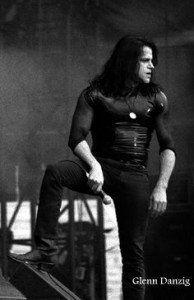
Oliver Stone’s Elektra: Assassin
Way back in 2003, when Daredevil was having a killer opening weekend, news came to light about Fox’s plans for a Daredevil sequel and Elektra spin-off. What many failed to mention was that a proposed Elektra project had already been in the works prior the property being sold to Fox.
As far back as 1992, Oliver Stone had been tinkering with the idea for a film called Elektra: Assassin, based on the mini-series by Frank Miller and Bill Sienkiewicz. Stone wanted Gabrielle Reece, the beautiful professional volleyball player and model, in the titular role.
With the rights to use S.H.I.E.L.D. and Nick Fury belonging to another studio, Stone changed the storyline up and instead of being hunted by S.H.I.E.L.D., like in the comic; Elektra would go up against the mystical ninja order, The Hand.
This would’ve been a great film had the film rights for Elektra, along with Daredevil, not been sold to Fox. Subsequently, Stone dropped out. For the proposed spin-off, Mark Steven Johnson (Daredevil’s director and writer of Elektra) announced that they had no plans on using the Elektra: Assassin story.
This is definitely the version that I would’ve wanted released rather than the underwhelming Fox film that was unleashed upon us. Have faith true-believers, though Oliver Stone might have moved on from this project, we might still yet be able to see this storyline picked up. With S.H.I.E.L.D. having their own successful television show and Elektra primed to appear in season 2 of Netflix’s Daredevil, there’s always a chance the two might eventually crossover… a chance.
Fantastic Four 3
You know, say what you want about the two Fox films, I didn’t think Fantastic Four (2005) and the sequel, Fantastic Four: Rise of the Silver Surfer(2007) weren’t bad (they weren’t really good by any stretch of the imagination, but not terrible films). The first film received mostly negative reviews but made a ton of money; so much so that the sequel was green lit despite of the reviews. After the sequel’s release to more generally not-good reviews but truck-loads of money, a trilogy was discussed.
The third film in the series was developed with a storyline in place as well possible casting lists generated. The film was to feature Franklin Richards, the mutant of Reed and Sue, who possesses the awesome ability to warp reality. The film was also to feature the Black Panther and would’ve contained more on the relationship between Ben Grimm and his blind girlfriend, Alicia Masters.
Writer Don Payne, who would go on to write both Thor and the sequel, Thor: The Dark World, was working on this third film. When speaking about what would have been in this third film, he noted the possibilities as he, “always loved the Inhumans, the Skrulls, the Puppet Master, and Annihilus and the Negative Zone.” Djimon Hounsou was being eyed for the role of the Black Panther, with Julian McMahon possibly to return as Doctor Doom, as he and the original cast signed on for three-picture deals. However, in 2009, after some time in development it was decided to reboot the franchise completely.
(Of course, Hounsou would later voice the Black Panther in a 2010 motion comic-style animated television series.)
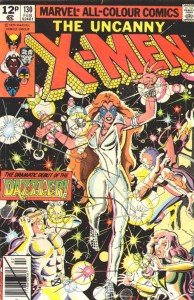
Wesley Snipes’ Black Panther
Speaking of the Black Panther, everyone knows that Marvel has announced the popular Wakandan ruler will appear in his own film in 2018. With Chadwick Boseman cast in the role, he will also make an appearance in next year’s Captain America: Civil War (2016). However, what you might not be aware of is that years before, even before Djimon Hounsou was rumored for the role in FF3, Wesley Snipes was linked to the character.
Snipes, best known for his role as the title character in Marvel’s Blade trilogy, had been pushing for a Black Panther film since 1992. At that time, Columbia was developing a big screen adaptation of the comic character. In a 1993 St. Petersburg Times article, Snipes says, “We have a wide-open field for comic book characters on the big screen and we’ve yet to have a major black comic book hero on the screen; especially the Black Panther, which is such a rich, interesting life. It’s a dream come true to originate something that nobody’s ever seen before.” With hopes of building a franchise, Snipes entered into negotiations with Columbia Pictures to portray the hero.
As with any film development, a major roadblock is finding the right script. After many dismal attempts, in March 1998, Marvel hired Joe Quesada and Jimmy Palmiotti to work on the adaptation, and by August 1999, Snipes was in place to produce and possibly star in the film. The following year Marvel struck a deal with Artisan Entertainment with the Black Panther being one of four films named to go into further development. Though by 2002, the project was still stuck in development. Snipes had already been portraying another Marvel property, Blade, since 1998, and announced in March 2002, that he planned on either making Blade 3 (Blade: Trinity) or Black Panther in the coming year. By this point, Snipes was so engrained in filmgoer’s minds as Blade that casting him as yet another Marvel character might be in excess. Not that it couldn’t be done, Chris Evans has played about four comic characters cinematically, two from Marvel Comics. So, it’s not unheard of but as time dragged on, Snipes role in the film was looking less and less likely to happen.
The film stayed in development as in 2005, Marvel Chairman Avi Arad stated as such, with Marvel President Kevin Feige reiterating the point in 2007. With the years dragging on and Snipes subsequent income tax evasion conviction and prison sentence, it seemed like this film would never get made. Different directors were attached with different writers all working on the project. Finally, in October 2014, Feige officially announced that Black Panther would be among Marvel’s “Phase Three” films, with a release date set for November 3, 2017.
Even after all these years, Wesley Snipes was still linked to the role all the way up until the official casting of Chadwick Boseman.
It seemed like a natural fit for Wesley Snipes, who is highly trained in the martial arts and is incredible shape. Despite this, at age 52, it was expected that Marvel would’ve gone with a younger actor. It seems that Snipes’ time has passed, but had the movie been made some twenty years ago, it most certainly would’ve rocked!
Superman Lives
I know I said that this list would contain ten almost-made films, but I would be remiss if I failed to include the one film that I teased in my introduction! So here it is; a bonus! As mentioned earlier, this film was set to go into production during the late 1990s. As the story goes, after Superman IV: The Quest for Peace failed, Warner Bros. and DC were frantic to breathe new life into the Superman franchise. They had a script worked up based on “The Death of Superman” storyline. The exact details of the script are unknown but it would have basically been Superman battling Doomsday to their mutual deaths, with Superman professing his love for Lois Lane as he lay dying in her arms. His spirit leaves his body (because lovelorn Kryptonians can do that, I guess) and rests in Lois who subsequently gives birth to a reborn Superman who matures quickly and takes up saving the world once again! The film was originally to be titled Superman V: Reborn.
That story didn’t sit well with the studio execs, so writer Gregory Poirier was brought and rewrote it, making Braniac the antagonist. In this story, still with the “Death” story at its center, Braniac was responsible for destroying Krypton and vows to destroy the last survivor, Superman.
Braniac travels to Earth, unleashing his monstrous creation, Doomsday upon Metropolis. Superman and Doomsday battle to the death, leaving Braniac victorious. After Superman’s funeral, Braniac attempts to steal his body but is foiled by a rogue government agency who claims the body themselves in hopes of cloning it.
While this is going on, Superman’s spirit is journeying through the afterlife and concludes that his work is not done and returns to its body. Originally powerless, the newly reborn Superman confronts Braniac and after regaining his powers, defeats him.
Again the studio was not satisfied and looked to writer Kevin Smith for a fan’s take on the story. This was 1996, and the studio was pushing for a release date sometime in 1998, the 60 year anniversary of Superman’s debut in Action Comics. When Smith was brought in to write, he had to first pitch his ideas to producer Jon Peters. Peters had a few stipulations. First, Superman couldn’t fly; Peters didn’t want to see him flying around. Second, no red briefs on his costume; Peters didn’t want to see any red “underwear” as part of his costume. Third, Superman somehow had to fight a giant spider in the third act; what Smith and Peters referred to as the “Thanagarian Snare Beast.”
Smith complied and turned in what was, from all accounts, a pretty good screenplay entitled Superman Lives. The story similarly involved Braniac, Doomsday, Lex Luthor, and a grand funeral sequence with a cameo by Batman. However, by this time, Tim Burton had been brought on to direct and he wasn’t too keen on Kevin Smith or his script. Burton brought in Wesley Strick and then Dan Gilroy to rewrite screenplays. Nicholas Cage was cast as Superman, Tim Allen and then Christopher Walken being eyed for Braniac. The script kept getting rewrites and the plot kept changing, resulting in the release date getting pushed back farther and farther until Cage dropped out in 2000, then Burton.
In October 2000, Keith Giffen turned in a treatment with Lobo as the main villain, though that idea was quickly scrapped. Finally, in February 2002, J.J. Abrams was brought on to write yet another script. Abrams abandoned the Superman Lives title and the “Death” story, instead wishing to reboot the franchise with Superman: Flyby.
This project would then go through numerous rewrites and would finally end up as the Bryan Singer film, Superman Returns, starring Brandon Routh. We all know how that turned out…
Should this film have been made? Maybe. It might have been just as big a failure as Superman Returns. Would it have made money? Certainly, Superman Returns did. Ultimately, I think the studio made the right choice in rushing through the development and releasing of Superman Lives. I still think they pulled the ripcord too soon in going ahead with Superman Returns. I know licensing options and contract dates have to be considered but I don’t think a studio should rush through any film project that isn’t ready to be made. Too many films are released that would’ve benefitted from more development. I think it was right to hold off on this one until just the write project came together. A fresh take was needed and I think they finally found it with Man of Steel.
As I also mentioned earlier, this past May 2015, a crowd funded, feature-length documentary titled The Death of “Superman Lives”: What Happened? was released by Jon Schnepp. The documentary goes into detail about the development of this project and its ultimate failure. It features tons of interviews, never-before-seen video of Nicholas Cage in Superman costume as well some great animatics and art from the scrapped project. If you get a chance, check it out!
So there you have it! A list of ten (plus one) comic book film projects that were almost made. Some were adapted into other projects sure, but none were produced as they were originally intended. Could we see some of them get a reprieve from development hell? Sure, it’s possible. All it takes is an innovative writer and a visionary director to pitch their take to the studio execs and – BOOM – greenlit movie!
I hope you found this interesting and I would love to hear your feedback. I know there are tons of similar films that died a slow death or are lingering in limbo somewhere. Stay tuned for another set that I’m researching and will have ready for you soon! If you know of any, I’d love to hear about them!
More links that may interest you:
6 Awful Things About Star Wars
4 Comic Book Films That Peaked 10 Minutes In







